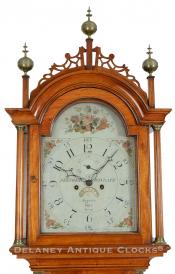Frederick Wingate of Augusta, Maine, in 1807, made this well-proportioned birch-wood case tall clock. It is his 30th clock. 223314.
This is a very early example. This case is constructed in birch and retains its original reddish tinting that was initially applied to the case to change the natural light color to a warmer tone similar to that of cherry and or mahogany. This process was common to clocks of this region. The secondary wood is New England white pine.
The case stands on cutout bracket feet that retain excellent height. They are visually separated from the base section with a simple applied molding. The waist door is rectangular-shaped and is trimmed with a molded edge. The selection of wood for this area of high visibility is excellent. The grain pattern is lively and exciting. The sides of the waist section are fitted with fluted quarter columns that terminate in brass quarter capitals. The bonnet features a New England-style pierced and open fretwork pattern of a traditional design. Three period brass finials are mounted on finial plinths. The bonnet columns are smoothly turned and nicely shaped. They are free-standing. They are mounted in brass capitals. The arched bonnet door is fitted with glass and opens to access the dial.
The clockmaker boldly signs This painted iron dial across the middle, “FREDERIC WINGATE.” Below the calendar, the dial reads, “Augusta / 9dated) 1807 / No 30.” The dial is decorated with colorful floral themes. The flowers in the spandrel areas are framed with gesso designs. The gesso is applied to the dial surface and then painted in gilt. A bouquet of flowers is present in the arch. The time track is formatted with Arabic-style hour numerals and five-minute markers. A dotted minute ring separates them. This dial also shows the seconds and the date of the month.
This fine movement is constructed in brass and is of good quality. Four-turned pillars support the two brass plates. Hardened steel shafts support the polished steel pinions and brass gearing. The winding drums are grooved. The escapement is designed in a recoil format. The weight-driven movement is designed to run for eight days on a full wind. It is a two-train or a time-and-strike design, having a rack and snail striking system. As a result, it will strike each hour on the hour on a cast iron bell mounted above the movement.
Inventory number 223315.
Frederick Wingate, silversmith, watch, and clockmaker, was born in Haverhill, Massachusetts, on January 11th, 1782, and died in Augusta, Maine, on November 16th, 1864. His parents were William Wingate (1745-1821) and Mehitable (Bradley) Wingate (1747-1796). He had an older brother, Paine Wingate (1767-1833), who was working in Boston as a clockmaker as early as 1789. Paine may have trained Frederick. Frederick married Hannah Page of Haverhill on January 17th, 1806. In 1814, he served as a soldier during the War of 1812.
Frederick worked as a silversmith, watch, and clockmaker and became one of Maine's most prolific clockmakers. He may have been trained in Massachusetts before he moved north to Augusta, Maine, by 1803. As a clockmaker, he made many tall, banjo, and mirror clocks. Many of the tall clock dials are numbered. Our family has recorded examples from low as number 15 to a high of 302. Frederick trained Benjamin Swan to make clocks in 1808. Swan was from Augusta, and his clocks are often very similar in form. They share similar characteristics, such as the use of contrasting woods. Reoccurring features found on many Augusta clocks are the use of figured maple in the waist door and base panel, unusual turned and often shaped waist and hood columns, and Boston-painted dials painted by Spencer Nolen. A fair number of Wingate clocks retain their original setup labels. If present, these can be found pasted inside the waist door.














